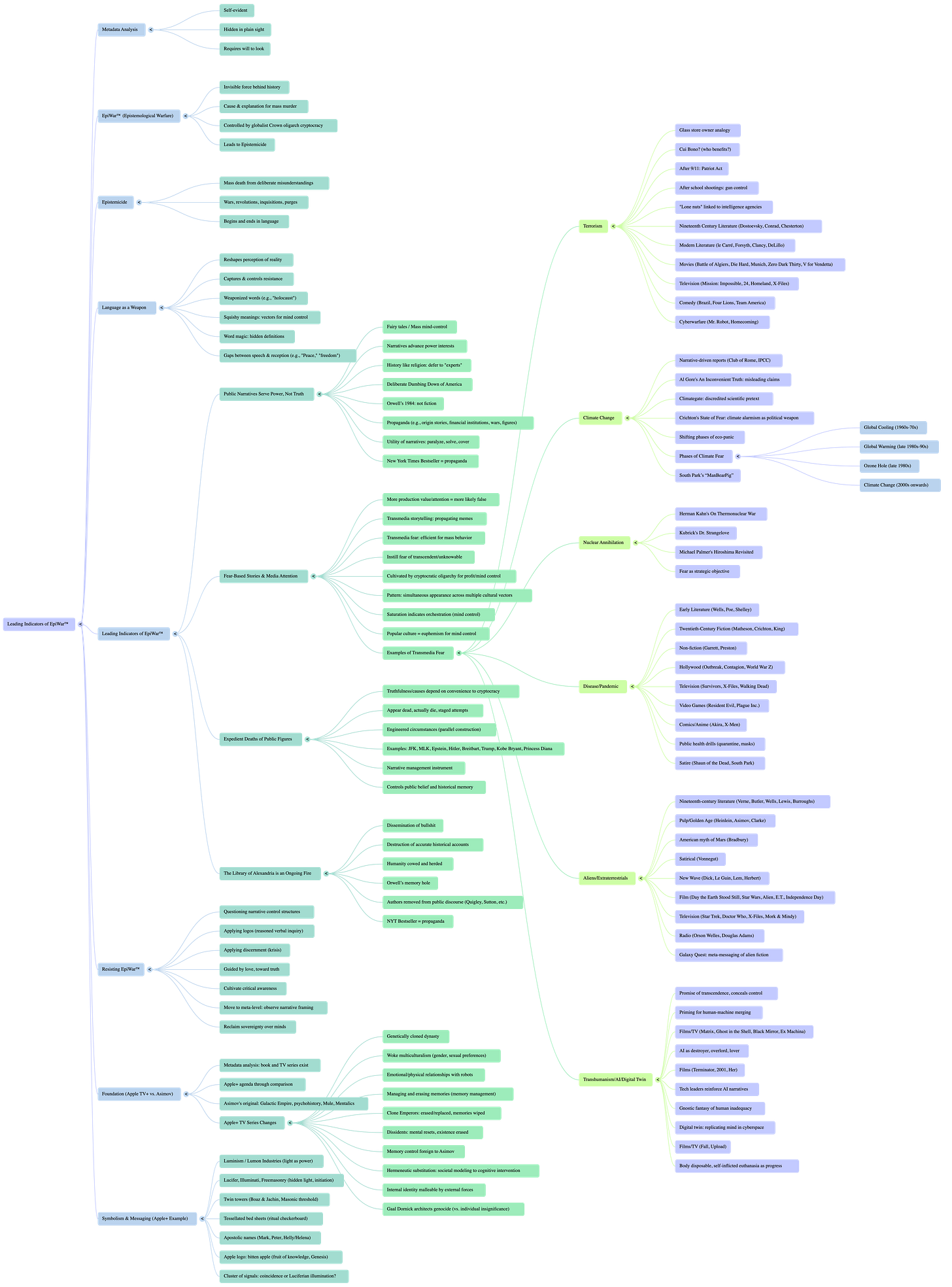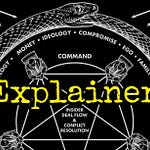A NotebookLM rendering of my latest post.
Study Guide
EpiWar™ and Narrative Control: A Comprehensive Study Guide
I. Core Concepts and Theories
This section examines the fundamental concepts outlined in "Leading Indicators of EpiWar™" to establish a robust theoretical foundation.
A. Epistemological Warfare (EpiWar™)
Definition: The invisible force behind history, serving as both cause and explanation for mass murder on a civilizational scale. It involves the manipulation of knowledge, language, and narratives to control perception and justify power.
Mechanism: Individuals and groups in power (the "globalist Crown oligarch cryptocracy") determine what knowledge is disseminated and how it is framed, leading to mass death (epistemicide) through deliberately created misunderstandings.
Historical Context: EpiWar™ is presented as a pattern observable in almost every major conflict over the last two thousand years.
Parmenides' "What Is" Rubric: The author uses Parmenides' philosophical concept of "what is" to advocate for examining self-evident presentations of media and ideas to identify manipulation.
B. Metadata Analysis
Definition: Analyzing information that is "hidden in plain sight" or "self-evident" within media and narratives.
Purpose: To uncover underlying agendas, manipulative intent, and the true purpose behind the creation and dissemination of information.
Examples: Comparing Isaac Asimov's Foundation novel with the Apple TV+ series adaptation to reveal an agenda of cognitive intervention and memory management.
C. Epistemicide
Definition: The mass death resulting from misunderstandings deliberately created by those who control knowledge.
Relationship to EpiWar™: It is the direct consequence and ultimate goal of successful epistemological warfare.
Mechanism: Wars, revolutions, inquisitions, and purges are initiated and sustained through the manipulation of language, vocabulary, and definitions, which reshape reality and suppress resistance before physical conflict begins.
Example: The weaponization of the word "holocaust" to frame mass murder as a ritual sacrifice, influencing public perception and behavior.
D. The Role of Language and Narratives
Weaponization of Words: Words with "squishy meanings" or multiple interpretations are used as "vectors for mind control" by "word magic"—assigning hidden definitions while the audience assumes another.
Controlled Gaps: The disparity between the speaker's intended meaning and the audience's reception of words like "peace," "freedom," or "progress" is crucial for control.
Narratives as Mind Control: Public narratives, often presented as "fairy tales," function as mass mind-control mechanisms. Their survival and spread are determined by their utility to power, not their truthfulness.
Shifting Narratives: Stories are altered over time to fit the "exigencies of the ruling power structure," maintaining an appearance of legitimacy.
Thanks to the generosity of my readers, all my articles are available for free access. Independent journalism, however, requires time and investment. If you found value in this article or any others, please consider sharing or even becoming a paid subscriber, who benefits by joining the conversation in the comments. I want you to know that your support is always gratefully received and will never be forgotten. Please buy me a coffee or as many as you wish.
II. Leading Indicators of EpiWar™
The study guide now delves into the four specific indicators the author proposes for identifying epistemological warfare.
A. Public Narratives are Amplified by How Well They Serve Power, Not Truth
Core Principle: The popularity and persistence of a narrative are directly proportional to its benefit to the ruling class, regardless of its factual basis.
Mechanism: Power players commission histories, fund media, and manage archives to ensure obedience and legitimacy.
Examples Include Origin stories for wars and revolutions, narratives surrounding financial institutions (such as the Federal Reserve and the Bank of International Settlements), and the promotion of figures like Lenin, Trotsky, Stalin, and Hitler.
Orwell's 1984: The author notes the similarity between modern narratives and the fictional world of 1984, where history is constantly rewritten.
B. The More Media Attention and Production Value a Fear-Based Story Has, the More Likely It Is to Be False
Core Principle: High production value and widespread media saturation of a fear-based narrative indicate orchestration and a deliberate attempt at mind control.
Transmedia Storytelling: The propagation of memes and fear across multiple media channels (news, films, TV, novels, video games, music) is a key strategy.
Transmedia Fear: This is identified as the "most efficient instrument for shaping mass behavior," often by instilling fear of something "transcendent or unknowable."
Pattern Recognition ("Chunking Up" / "Going Meta"): Recognizing the ubiquity and repetitive patterns across various media reveals the scope of the "attack" and its function as psychological conditioning.
Examples of Fear Narratives:Terrorism: Portrayed across literature (Dostoevsky, Conrad, le Carré, Clancy), film (Die Hard, Air Force One, United 93), and television (24, Homeland, X-Files), often linked to "lone nuts" or fringe groups with intelligence agency ties.
Climate Change: Shifting narratives from global cooling (1960s-70s) to global warming (1980s-90s) to ozone depletion, and finally consolidating under "climate change." Propagated through films (An Inconvenient Truth, The Day After Tomorrow), literature (Atwood, Robinson), and documentaries. The narrative persists despite scientific discrediting (Climategate) or factual inaccuracies (Al Gore's claims).
Nuclear Annihilation: Institutionalized through works like On Thermonuclear War and mocked in Dr. Strangelove, suggesting the fear itself is the strategic objective.
Disease/Plandemics: A long history in literature (Wells, Poe, Shelley, Matheson, Crichton, King) and film (Outbreak, Contagion, World War Z), including themes of lab leaks, weaponized viruses, and a "pre-script" for events like Covid-19.
Alien/Extraterrestrial Life: Explored in literature (Verne, Wells, Heinlein, Asimov, Dick, Le Guin) and film/TV (Star Wars, Alien, Star Trek, The X-Files), often for fear, satire, or as tools for societal critique. Galaxy Quest is highlighted for inverting this, with aliens mistaking human TV shows for reality, raising questions about meta-messaging.
Transhumanism and AI: Presented as promises of transcendence but concealing programs of control. Narratives of enhanced intelligence, immortality, and engineered evolution (The Matrix, Ghost in the Shell, Terminator, 2001: A Space Odyssey) mask underlying dependencies and promote a "Gnostic fantasy" that humans are inadequate. The "digital twin" concept is framed as encouraging "self-inflicted euthanasia" under the guise of progress.
C. The Explanation of the Death of a Lightning-Rod Persona, Its Truthfulness, and Causes Depend on How Convenient the Death Is Perceived to Be
Core Principle: Convenient deaths—whether factual or fabricated—are used as instruments of narrative management to mold public belief and historical memory.
Mechanism: Real Deaths: Used to create martyrs or remove opposition.
Engineered Deaths (Parallel Construction): Circumstances are manipulated to appear as alternative causes, thereby obscuring the true intent.
Faked/Failed Attempts: Staged events to shape public opinion or redirect suspicion.
Impact: Assassinations create martyrs, staged deaths erase liabilities, and ambiguous cases generate speculation that fractures public discourse, serving the cryptocracy's strategic objectives.
Examples: John F. Kennedy, Martin Luther King, Jeffrey Epstein, Andrew Breitbart, Robert Maxwell, and many others whose deaths are presented as questionable or serving specific power agendas.
D. The Library of Alexandria Is an Ongoing Fire
Core Principle: The deliberate destruction of accurate historical accounts and the dissemination of "bullshit" (propaganda) to control and herd humanity.
Mechanism: The suppression of truthful information and the promotion of official, often false, narratives.
"Memory Hole" (Orwell): Valuable alternative historical renderings are effectively "dropped down" or made to disappear.
"Conspiracy Theorist" Label: Weaponized since 1963 to discredit individuals and ideas that question narrative control.
Suppressed Authors: A list of authors (Carroll Quigley, Antony Sutton, James Corbett, etc.) whose works challenge official narratives and are often out of print or not "New York Times Bestsellers," indicating their suppression.
New York Times Bestsellers: Presented as a "tell" that such books are likely propaganda.
III. Cultivating Critical Awareness and Resistance
Logos (λόγος) and Discernment (κρίσις): The author advocates for reasoned verbal inquiry and discernment, guided by love and truth, to cultivate critical awareness.
Moving to the Meta-Level ("Chunking Up"): Observing how narratives frame reality to reclaim sovereignty over one's mind and resist EpiWar™.
Call to Action: To read suppressed authors, question mainstream narratives, and recognize patterns of manipulation.
IV. Supplemental Information and Key Terminology (Refer to Glossary)
Parmenides, On Nature: Philosophical inspiration for examining "what is" as self-evident truth.
Isaac Asimov's Foundation: Used as a case study for metadata analysis, comparing the original book to the Apple+ series.
Apple+ TV Series Severance: Another example of memory erasure trope and shared symbolic ideas (Luminism, Lumon Industries, Masonic imagery).
Al Gore's An Inconvenient Truth: Critiqued for misleading claims and its role in propagating climate fear.
Carroll Quigley Interview: Highlighted as an example of an author who crossed the "invisible line of power."
Parallel Construction: A method used by "handlers" to create a "clean" official account of how evidence was obtained, obscuring its true, often legally questionable, source.
Cryptocracy: A secret government or a government whose real rulers are hidden. The text refers to a "globalist Crown oligarch cryptocracy."
Luminism/Lumon Industries: Symbolic references to "light" and knowledge, potentially signaling Luciferian illumination or controlled knowledge.
Masonic Imagery: References to "Boaz and Jachin" (pillars of Solomon's Temple), "black-and-white tessellated bed sheets," and the "bitten apple" logo as indicators of a ritualistic narrative structure.
Quiz: Leading Indicators of EpiWar™
Instructions: Answer each question in 2-3 sentences, demonstrating your understanding of the source material.
What is the author's definition of "Epistemological Warfare" (EpiWar™), and what is its historical significance?
Explain the concept of "metadata analysis" as presented by the author, and provide an example from the text.
What is "Epistemicide," and how does it relate to EpiWar™?
According to the author, how are language and vocabulary used as primary vectors in epistemological warfare?
Describe the first leading indicator of EpiWar™ concerning public narratives. What determines a narrative's survival?
The second leading indicator discusses fear-based stories. What does high media attention and production value suggest about these stories?
What is "transmedia storytelling," and how is it utilized in epistemological warfare, particularly with "transmedia fear"?
Explain the third leading indicator of EpiWar™ regarding "lightning-rod persona" deaths. What is the cryptocracy's objective in managing these deaths?
What does the author mean by "The Library of Alexandria is an ongoing fire" in the context of EpiWar™?
How does the author suggest individuals can cultivate critical awareness and resist epistemological warfare?
Quiz Answer Key
Epistemological Warfare (EpiWar™) is defined as the invisible force behind history, acting as both the cause and explanation for mass murder on a civilizational scale. Its historical significance lies in its observable pattern across major conflicts for the last two thousand years, driven by the manipulation of knowledge by a globalist cryptocracy.
Metadata analysis involves recognizing information "hidden in plain sight" or "self-evident" within media. It aims to uncover underlying agendas without extensive effort beyond the will to look. An example is comparing Isaac Asimov's Foundation novel with the Apple+ TV series to determine if the show's backers had an agenda to sell specific concepts.
Epistemicide is the mass death resulting from misunderstandings deliberately created by those who control knowledge. It relates to EpiWar™ as the ultimate consequence, where the manipulation of perception through language and narratives leads to millions of deaths by shaping choices and actions.
Language and vocabulary are used as primary vectors in EpiWar™ through "word magic," where oligarchs assign hidden definitions to words while the audience assumes common meanings. This creates "squishy meanings" that reshape people's perception of reality and capture their capacity to resist.
The first leading indicator states that public narratives are amplified by how well they serve power, not truth. Narratives survive and spread when they advance the interests of those in power, regardless of their factual accuracy, functioning as mass mind-control mechanisms that evolve to fit ruling structures.
High media attention and production value for a fear-based story suggest that it is more likely to be false and serves as a tool for mind control. The saturation itself indicates orchestration by the cryptocracy, aiming to induce compliance through engineered narratives.
Transmedia storytelling is the propagation of memes across multiple media channels, such as news, films, TV, and video games. "Transmedia fear" is its most efficient instrument, shaping mass behavior by instilling fear of the unknown, and its ubiquity signals an orchestrated "multi-channel informational assault."
The third leading indicator suggests that the truthfulness and perceived causes of a "lightning-rod persona's" death depend on its convenience to the ruling cryptocracy. The objective is narrative management, where real or fabricated deaths create martyrs, erase liabilities, or generate fracturing speculation, thereby molding public belief.
By "The Library of Alexandria is an ongoing fire," the author means that accurate, truthful accounts of history are continuously being destroyed and replaced with "bullshit" (propaganda). This process serves to cow and herd humanity, preventing them from understanding their true past and the forces they are subjected to.
The author suggests individuals cultivate critical awareness by applying logos (reasoned inquiry) and krisis (discernment), guided by love and truth. This involves moving to the "meta-level" or "chunking up" to observe how narratives frame reality, thereby reclaiming sovereignty over one's mind and resisting EpiWar™.
Essay Questions
Analyze how the Apple+ TV series Foundation is used as a case study to illustrate the mechanisms of EpiWar™, specifically focusing on the concepts of cognitive intervention, memory management, and the hermeneutic substitution from Asimov's original work.
Discuss the weaponization of language and narratives in EpiWar™. How do "word magic" and the "controlled gaps" between speech and reception contribute to epistemicide and the shaping of public perception? Provide specific examples from the text.
Examine the role of fear-based narratives, particularly terrorism and climate change, as leading indicators of EpiWar™. How do transmedia storytelling and high production value signal orchestration and function as tools for mass psychological conditioning?
Evaluate the author's claim that the deaths of "lightning-rod personae" are instruments of narrative management. Choose at least three examples from the provided list and discuss how their real or fabricated deaths could serve the cryptocracy's strategic objectives.
Reflect on the author's call to action regarding "The Library of Alexandria is an ongoing fire." Discuss the significance of suppressing certain authors and historical accounts, and explain the author's proposed methods for individuals to resist this aspect of EpiWar™ and reclaim critical awareness.
Glossary of Key Terms
Epistemological Warfare (EpiWar™): The invisible force driving historical conflicts, involving the manipulation of knowledge, language, and narratives to control perceptions, justify power, and ultimately lead to mass death.
Parmenides' "What Is" Rubric: A philosophical principle from Parmenides' On Nature that advocates for examining self-evident truths ("what is") to discern reality and identify manipulation, as opposed to believing in "what is not."
Metadata Analysis: The process of identifying and interpreting "hidden in plain sight" or "self-evident" information within media and narratives to uncover underlying agendas and manipulative intent.
Epistemicide: The mass death resulting from misunderstandings deliberately created by those who control knowledge. It is the ultimate consequence of successful epistemological warfare.
Word Magic: The process in EpiWar™ where those in power assign hidden or alternative definitions to words, while the public assumes common meanings, creating a gap between speech and reception that facilitates mind control.
Controlled Gaps: The deliberate disparity between the intended meaning of words used by those in power and the public's understanding, which is exploited to control outcomes, including who lives and who dies.
Public Narratives: Stories, cultural accounts, and historical interpretations disseminated to populations, which, in the context of EpiWar™, often function as "fairy tales" and mass mind-control mechanisms designed to serve power, not truth.
Transmedia Storytelling: A method of propagating ideas, memes, and narratives across multiple media channels (e.g., news, films, TV, literature, video games) to ensure widespread dissemination and saturation.
Transmedia Fear: A specific application of transmedia storytelling that instills fear, often of something "transcendent or unknowable," as an efficient instrument for shaping and controlling mass behavior.
Chunking Up / Going Meta: A cognitive process of stepping back to observe the broader patterns and structures of narratives across various media, enabling recognition of orchestrated mind-control "programs."
Lightning-Rod Persona: An influential or prominent individual whose death (real or fabricated) is strategically managed by the cryptocracy to manipulate public opinion, manage narratives, create martyrs, erase liabilities, or fracture public discourse.
Parallel Construction: A deceptive tactic where handlers obtain information from a hidden or questionable source but then create a "clean," official, and seemingly lawful account of how the evidence was "discovered," obscuring its true origin.
The Library of Alexandria is an Ongoing Fire: An analogy used to describe the continuous, deliberate destruction of accurate, truthful historical accounts and the dissemination of propaganda ("bullshit") to control humanity's understanding of reality.
Cryptocracy: A secret government, or a government whose true rulers and their operations remain hidden from public view, often referred to as the "globalist Crown oligarch cryptocracy" in the text.
Luminism / Lumon Industries: Symbolic names (from Foundation and Severance) derived from "lumen" (light), potentially signaling a controlled form of knowledge, Luciferian illumination, or a secret society's influence.
Masonic Imagery: References to specific symbols (e.g., Boaz and Jachin, tessellated checkerboards, the bitten apple logo) embedded in media, which the author suggests are deliberate cues signaling ritualistic narrative structures or an underlying agenda from groups like Freemasonry or the Illuminati.
Logos (λόγος): Greek for "reasoned verbal inquiry" or "discourse," advocated by the author as a tool for critical thinking and discerning truth in the face of EpiWar™.
Discernment (κρίσις): Greek for "judgment" or "the act of separating," emphasized as a crucial skill for critical awareness, guided by love and truth, to analyze and interpret narratives.
Detailed Briefing
Executive Summary
The provided source, "Leading Indicators of EpiWar™" from The Duke Report, argues for the existence of Epistemological Warfare (EpiWar™), a systematic and deliberate manipulation of knowledge, narratives, and perceptions to control populations and justify the actions of a "globalist Crown oligarch cryptocracy." The report asserts that this form of warfare operates by shaping public understanding through various media, weaponizing language, and fabricating or managing events, including deaths, to suit the agenda of those in power. Key themes include the subversion of truth for power, the strategic use of fear-based narratives, the engineering of prominent deaths, and the systematic suppression of dissenting historical accounts. The author proposes a framework for identifying these "leading indicators" to cultivate critical awareness and resist mental manipulation.
Core Concepts and Main Themes
1. Epistemological Warfare (EpiWar™) and Epistemicide
Definition: EpiWar™ is presented as the "invisible force behind history," a systematic manipulation of knowledge to control populations. It serves as "both cause and explanation for mass murder on a civilizational scale."
Mechanism: It operates by controlling "how we will come to know what we will know," through deliberate choices made by those in power.
Result: Epistemicide: This term describes "the mass death resulting from misunderstandings deliberately created by those who control knowledge." The author claims that the number of deaths produced through epistemicide across centuries far exceeds commonly understood historical atrocities like the Holocaust, stating, "Six million sounds like a lot until you think about the six hundred million; it’s a small fraction of that."
2. The Weaponization of Language and Narrative Control
Wars begin and end in language: "Vocabulary and definitions are used to reshape people’s perception of reality... and their capacity to resist is captured and controlled before weapons can be drawn."
Multiple Meanings (Metadata of Words): Words with "squishy meanings" become "vectors for mind control," through a process the author calls "word magic." This involves "wrapping self-evident truth in a mystery – assigning hidden definitions, while those who hear them assume or presuppose another meaning or belief."
Examples of Weaponized Words: The report cites "holocaust," "Peace" (meaning "the absence of opposition to their power"), "freedom," "liberty," "liberal," "conservative," "hope," "change," and "progress" as examples of words whose "gaps between speech and reception" are controlled to determine "who lives and who dies."
Public Narratives Serve Power, Not Truth: "A narrative survives and spreads when it advances the interests of those who hold power. Truth does not decide how long it lasts. Stories change over time to fit the exigencies of the ruling power structure."
Propaganda as Mass Mind-Control: Popular histories and cultural narratives are described as "fairy tales" that "function as mass mind-control mechanisms," ensuring obedience and legitimizing the ruling power structure. This is compared to religious adherence, where populations defer to "expert" journalists, officials, and historians.
Orwellian Reality: The report explicitly states, "In the end, Orwell’s 1984 doesn’t feel like fiction," highlighting the perceived reality of historical revisionism and narrative control.
3. Fear-Based Transmedia Storytelling
Ubiquitous Fear as Mind Control: The report posits that "transmedia fear is the most efficient instrument for shaping mass behavior." This strategy involves instilling fear of "something transcendent or unknowable" through a multi-channel informational assault.
Pattern Recognition: The author argues that when "every medium reinforces the same fear, the story functions as mind control." The "saturation itself indicates orchestration" and is a "tell" that a fear-based narrative is likely false, especially if it has high media attention and production value.
Terrorism as a Structural Element: Terrorism is presented as a pervasive theme in popular culture since the 19th century, serving to generate fear and justify specific political agendas. The "metadata to look for in most terror attacks is what politicians and leaders are calling for right after the attack," with "Cui Bono" (who benefits?) as the guiding question. Examples like 9/11 leading to the Patriot Act, and school shootings leading to gun control, are provided.
Climate Change Narratives: The report details how climate fear has shifted through "global cooling," "global warming," "ozone hole panic," and finally "climate change," each phase saturating media with apocalyptic visions. Figures like Al Gore are cited for promoting "fear-porn film[s]" like "An Inconvenient Truth," which contained "misleading or exaggerated" claims. The purpose of these narratives is to create "imaginary dangers" and to make the public "perpetually in need of guidance from experts, governments, or corporations."
Pandemic/Disease Narratives: Disease outbreaks are portrayed as a long-standing "narrative engine" in popular culture, from early literature to modern films and video games. "Steven Soderbergh’s Contagion (2011) provided the most clinical rehearsal, mapping quarantine, masks, vaccine development, and 'misinformation' campaigns — an exact pre-script for Covid-19."
Alien/Extraterrestrial Narratives: The omnipresence of alien themes in literature, film, and television is noted, with "Galaxy Quest" presented as a meta-example where "aliens think TV shows about humans in space are real."
Transhumanism and AI Fear: These narratives are presented as "canards" that project a "Gnostic fantasy that humans, as they are, are not good enough."
Transhumanism: "Seductive images of superhuman capability mask the underlying dependence on hidden operators," training audiences to "reject their own being in favor of engineered improvement."
AI Fear: Conditions audiences to "fear collapse or enslavement" and encourages submission to "machine guidance" by presenting a future where "thought and decision-making are no longer sovereign."
Digital Twin: This concept is viewed as an illusion designed to convince populations that "abandoning their mortal frame is an act of progress when it is a suicidal submission to control."
4. Expedient Deaths and Narrative Management
Controlled Perception of Death: The "explanation of the death of a lightning-rod persona, its truthfulness, and causes depend on how convenient the death is perceived to be." The "ruling oligarch cryptocracy" can engineer deaths, or even "faked and failed attempts," to shape public opinion and redirect suspicion.
Examples: A long list of prominent figures is provided, including JFK, RFK, MLK, Jeffrey Epstein, Adolf Hitler (assumed dead, evidence unsettled), Andrew Breitbart (sudden "heart attack"), and numerous others from politics, entertainment, and science. The report questions whether these deaths were "real death that benefited exactly who?" or were "engineered through parallel construction."
Parallel Construction: This technique involves handlers obtaining evidence from questionable sources and creating a "clean, official account of how they 'discovered' it," obscuring the true origin of information.
Purpose: These deaths "serve as instruments of narrative management," allowing the cryptocracy to "mold public belief and historical memory," create martyrs, erase liabilities, or generate "endless speculation that fractures public discourse."
5. The Ongoing "Library of Alexandria" Fire (Suppression of Truth)
Destruction of Accurate History: The report laments the "dissemination of bullshit and the destruction of accurate, truthful accounts of history," which leaves "humanity... cowed and herded like cattle."
Orwell's Memory Hole: Numerous authors and their works are cited as examples of "thoughtful renderings of the past that have been dropped down Orwell’s memory hole," often because they "dared to reveal things that power did not want revealed."
"New York Times Bestseller" as a "Tell": The author suggests that a book appearing on this list usually indicates "bullshit that you should assume is propaganda the Power Elite wants you to consume without thinking."
"Conspiracy Theorist" as a Weapon: The term "conspiracy theorist" has been "officially weaponized since 1963 to shut down people and the ideas that ask questions."
Leading Indicators of EpiWar™ (Summary from Source)
The author provides a concise list of leading indicators:
Public Narratives are Amplified by How Well they Serve Power, Not Truth.
The more media attention and production value a fear-based story has, the more likely it is to be false.
The explanation of the death of a lightning-rod persona, its truthfulness, and causes depend on how convenient the death is perceived to be.
The Library of Alexandria is an ongoing fire.
Call to Action/Methodology for Resistance
Critical Awareness: The report encourages readers to apply "Parmenides' 'what is' rubric" and examine "the self-evident presentation of media and ideas that surround us" to determine how "we are being manipulated and how we become victims of epistemological warfare."
"Going Meta" / "Chunking Up": This involves recognizing the patterns of disseminated ideas across multiple media to see the "repetitive patterns" and orchestration of narratives.
Reclaiming Sovereignty: By practicing "logos (λόγος) as reasoned verbal inquiry and discernment (κρίσις), guided by love, in the direction of truth," individuals can "reclaim sovereignty over our own minds and resist the machinery of epistemological warfare."
Metadata and Hidden Signals (Apple+ Examples)
The report uses Apple+ TV series Foundation and Severance as "thought experiment[s]" to illustrate how powerful backers might "sell" concepts to an audience through metadata analysis.
Foundation vs. Asimov's Original: The Apple+ series introduces "memory management as a tool of the empire," a concept "entirely foreign to Asimov’s original framework." This indicates a "hermeneutic substitution" from societal modeling to "cognitive intervention," where "internal identity is malleable by external forces."
Woke Multiculturalism: The series is critiqued for including "genetically cloned dynasty, genders, sexual preferences, and roles of main characters transformed to fit woke multiculturalism, an openly gay rebellious general, with a boy-toy 'husband2,' emotional and physical relationships with robots."
Luciferian Illumination & Masonic Symbolism: Both Foundation and Severance are analyzed for recurring symbolic ideas related to "Luminism" (light/knowledge), "twin towers" (Boaz and Jachin of Solomon's Temple/Masonic initiation), "black-and-white tessellated bed sheets" (ritual checkerboard), and apostolic names (Mark, Peter, Helly/Helena). The Apple logo itself (a bitten apple) is interpreted as a "direct gesture to the fruit of knowledge in Genesis," framing the entire enterprise as "an echo of the first illumination — Eve’s bite into forbidden knowledge." These recurring signals are questioned as either a coincidence or "not-so-subtle hint at Luciferian illumination, woven into the fabric of entertainment by design."
Council on Foreign Relations: Al Gore and Laurence Bender (producer of "An Inconvenient Truth") are identified as members of this "cryptocratic organization."














